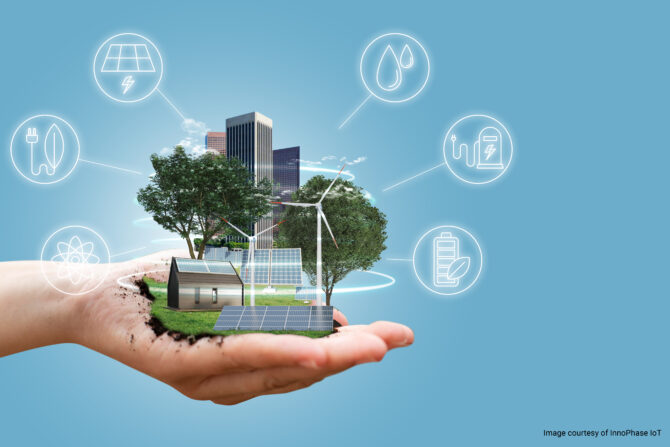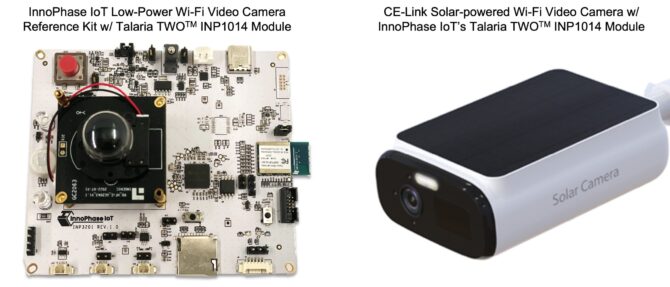
Choosing low power IoT devices to achieve sustainability
By Deepal Mehta, Sr. director, marketing and business development, InnoPhase IoT
Electronics Wireless IoT Editor Pick InnoPhase IoT Wi-Fi wirelessShaping the future of energy efficiency and reality of landfills
The number of active IoT devices globally is expected to grow from 7.6 billion in 2019 to 24.1 billion in 2030, according to reports from Transforma Insights. There are many reasons for such growth, but, what’s particularly exciting is the fact that many technology advances have lined up recently to enable IoT capabilities previously unseen.
Harnessing such technology advances as making strides in battery life, the combination of battery and Wi-Fi in IoT devices, the use of the cloud that complements rather than takes over, sensor technology at the edge, the growing use of artificial intelligence (AI) and machine learning (ML), will fuel growth and deliver the next wave of more meaningful and useful IoT devices.
Battery life
Customers currently expect IoT devices to have a battery life of at least 10 years, compared to the not-too-distant past when expectations were that they would last at most a few years. The battery life of an IoT device determines its performance and efficiency. Manufacturers are now using integrated circuits (ICs) with deep sleep modes that consume less power, slow clock speeds, feature reduced instruction sets, and have minimal current draw, Efficient techniques such as system level power savings and cloud connectivity optimizations result in longer life and smaller battery size. Battery life measurement and optimization are key design considerations of IOT applications.

Source: InnoPhase IoT
IoT devices now demand ultra-low power Wi-Fi at BLE power levels. Today’s multi-protocol wireless solutions are beginning to integrate Wi-Fi, BLE and Thread to enable a myriad of new applications. The use of Integrated (Wi-Fi + BLE5.0) delivers long range operation suitable for smart door locks, remote security cameras, connected sensors, and space constrained products inside and outside of the home.
IoT at the edge
According to a recent report by Gartner, by 2025, 75% of enterprise-generated data will be created and processed at the edge. Edge computing reduces latency, dramatically increases efficiency, and improves security, revolutionizing IoT data processing and storage. Processing data locally reduces the amount of data that goes to the cloud for processing and storage, saving power and increasing battery life) Cloud-based systems are not replaced, but are complemented, yielding efficiency and increased data analysis when edge computing combines with the cloud. An example of its importance is seen with latency. Edge computing reduces latency to 5-10 milliseconds from 25-35 milliseconds in already deployed devices.
Direct-to-cloud connectivity means that no intermediate gateway is needed for IoT applications. Cloud services are available on-demand and are used to efficiently meet the ever-growing demand for IoT.
Energy efficiency, sustainability
The IoT battery-based Wi-Fi market is expected to reach 1 billion units by 2025, according to ABI Research. Battery-based IoT devices are now capable of efficiently monitoring energy-consumption and controlling it in real time. Examples include smart homes that make automatic adjustments to lower energy demand and increase efficiency. IoT provides insights that are timely, precise, and accurate. For example, IoT sensor-based smart thermostats automatically adapt room temperature based on occupancy and the habits of residents, and provide finer-grained temperature zones and vent control throughout the home. Increasingly, these technologies are becoming battery based.

Source: InnoPhase IoT
Wireless modules and SoCs are solving the most critical issue impeding growth—the drastic reduction of power consumption in battery-based IoT devices. For example, InnoPhase IoT’s Talaria TWO Wi-Fi + BLE platform is untethering products, allowing select IoT devices to be battery-based for the first time. Modules integrate wireless connectivity and microcontrollers at the edge for IoT designs based on direct-to-cloud and ultra-low power. The entire module family employs a Talaria TWO Multi-Protocol SoC, with Wi-Fi and BLE5 for wireless data transfer, an embedded Arm Cortex-M3 for system control and user applications plus advanced security. It’s the only digital power radio architecture delivering the world’s lowest power Wi-Fi solution available in a semiconductor device. InnoPhase IoT’s sensor-to-cloud customer applications based on the platform offer IoT products with approximately10 years of battery life. It also offers Wi-Fi provisioning through BLE, secure over-the-air updates, and efficient power management features, making it an ideal choice for building reliable and long-lasting IoT devices.
The challenge for OEMs and ODMs is finding providers with sufficient proven use cases combined with a toolbox of the right technologies, available today, that can move IoT devices into new applications fast. And that challenge will be heightened as the Matter platform continues to expand. Simple, interoperable, reliable, and secure, Matter relies on IP connectivity and supports protocols such as Wi-Fi and Thread, and BLE for commissioning purposes.
These technologies, coming together are providing the efficiency and sustainability IoT demands. They also go far in solving the next problem—keeping batteries out of landfills.
Reality of Landfills
Untethering IoT devices and achieving long battery life are at the heart of today’s IoT efforts. Long IoT battery life is important on many levels. Not only does it determine device performance and efficiency, but batteries often are also installed in remote or hard-to-access locations, where replacing/recharging them is difficult.
There’s also an important disconnect between battery and device life. While most IoT sensors and sensor nodes have an expected battery lifespan of between one and three years, for example, IoT device life cycles are 10 to 20 years or even more. As battery lifespan becomes more in line with device life, there will be fewer to dispose of.
Today, approximately 5% of lithium-ion batteries are recycled. Between 2017 and 2030 estimates are that approximately 8 to 11 million tons of lithium-ion batteries will be disposed of in landfills as waste. Eliminating batteries, or dramatically curtailing their use is obviously important and will become even more so as regulations are created and upheld.
The enabling of battery based IoT devices that operate efficiently and sustainably at the edge is taking place now. Until recently, approximately 5% of IoT devices were battery powered. That number is rapidly exploding to 10-20% in the next couple of years and growing to as much at 50% over the next 3-5 years. Driving the growth of the IoT revolution towards multi-billions of devices in a sustainable and responsible manner without having explosive growth of landfills is the calling for our industry today. For IoT device designers, it’s important to choose a partner with expertise to bring together all the underlying advanced technologies to bring energy efficiency and sustainability to exciting new use cases—not tomorrow, but today.
————————————————–
InnoPhase IoT specializes in extreme low-power wireless IoT solutions and developed an award-winning Talaria TWO Wi-Fi + BLE platform.
